|
Thursday, May 2
- Breakfast: corned-beef hash and eggs
- White chicken chili
- Chicken quesadilla
- Honey baked ham
- Smart cuisine: Mediterranean-style ziti with asparagus
- Buffalo chicken tender wrap
- Assorted pizza by the slice
- Grilled- or crispy-chicken Caesar salad
Wilson Hall Cafe menu |
|
Friday, May 3
Dinner
Closed
Wednesday, May 6
Lunch
- Apple- and horseradish-glazed salmon
- New potatoes with dill
- Roasted broccoli
- Lemon cake
Chez Leon menu
Call x3524 to make your reservation.
|
|
New dark matter detector begins search for invisible particles
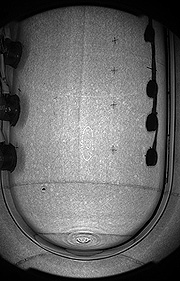 |
This is an image of the first particle interactions seen in the COUPP-60 detector, located half a mile underground at SNOLAB in Ontario, Canada. Photo: SNOLAB
|
Scientists this week heard their first pops in an experiment that searches for signs of dark matter in the form of tiny bubbles.
Scientists will need further analysis to discern whether dark matter caused any of the COUPP-60 experiment's first bubbles.
"Our goal is to make the most sensitive detector to see signals of particles that we don't understand," said Hugh Lippincott, a postdoc with the Department of Energy's Fermi National Accelerator Laboratory who has spent much of the past several months leading the installation of the one-of-a-kind detector in a laboratory a mile and a half underground.
COUPP-60 is a dark-matter experiment funded by DOE's Office of Science. Fermilab managed the assembly and installation of the experiment's detector.
The COUPP-60 detector is a jar filled with purified water and CF3I—an ingredient found in fire extinguishers. The liquid in the detector is kept at a temperature and pressure slightly above the boiling point, but it requires an extra bit of energy to actually form a bubble. When a passing particle enters the detector and disturbs an atom in the clear liquid, it provides that energy.
Dark-matter particles, which scientists think rarely interact with other matter, should form individual bubbles in the COUPP-60 tank.
"The events are so rare, we're looking for a couple of events per year," Lippincott said.
Other, more common and interactive particles such as neutrons are more likely to leave a trail of multiple bubbles as they pass through.
Over the next few months, scientists will analyze the bubbles that form in their detector to test how well COUPP-60 is working and to determine whether they see signs of dark matter. One of the advantages of the detector is that it can be filled with a different liquid, if scientists decide they would like to alter their techniques.
Read more
|
13th Argonne-UChicago-Fermilab collaboration meeting on May 28
The 13th Argonne-UChicago-Fermilab collaboration meeting will take place Tuesday, May 28, from 1 to 6 p.m. at Fermilab. A reception will follow. The agenda is available online, and registration is open.
More than 70 scientists from the three institutions will share ideas about future projects and the institutions' strategic plans. The focus of this year's meeting is the institutions' connections with Latin America. Presenters will also discuss the Fermilab Campus Master Plan, accelerators and accelerator stewardship at the laboratories, and the University of Chicago's collaborative initiatives in particle physics R&D.
The collaboration meetings, started in 2006 by Fermilab and Argonne, initially focused on accelerator research and development. Over the years the meeting's scope has broadened to include topics related to all aspects of particle physics research.
If you plan to attend, please register. Be sure to note in the registration page's designated field whether you will attend the reception.
|
Fermilab offers benefits for new parents and parents-to-be
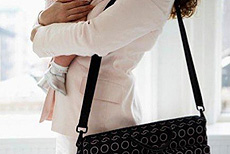 |
Fermilab's WDRS wants to make the transition both to parenthood and
back to work as easy as possible. |
Being a new or an expectant parent can be stressful. That's why Fermilab offers a number of benefits and resources designed for new parents or parents-to-be.
The Maternity Closet, located in the Daycare Center in the Village, offers a selection of gently used maternity clothes, which are available to all employees or users and their partners. So dressing comfortably and fashionably—both at work and at home—is possible without spending too much money. If you have maternity clothing to donate, The Maternity Closet gladly accepts clothing contributions. Please call Daycare at x3762 if you would like to donate clothing. WDRS thanks you in advance for helping fellow working parents.
The Nursing Mother's Room, located in Wilson Hall on the 9th floor, provides a comfortable, clean and quiet environment with full privacy—a helpful benefit for new Fermilab moms. Contact Kathleen Venn Bowers for information on how to reserve the room.
For more information on benefits for new or expecting parents, stop by the Benefits Department on Wilson Hall's 15th floor to pick up a copy of the new parent guide. You can also view an electronic version. And, as always, your HR generalist is available to answer your questions and be your first point of contact for all HR-related needs.
|
Detector in South Pole's ice cap spots rare high-energy neutrinos
From ars technica, April 29, 2013
Some of the earliest and most successful neutrino detectors were based on enormous tanks of water. For example, Japan's Super Kamiokande held 3,000 tons of water, and researchers used the detector to watch for a sign that a neutrino had bumped up against one of the water molecules. A recently constructed detector takes a similar approach, observing about a cubic kilometer of water using over 5,000 optical sensors. It just relies on nature to provide the water. The detector is called IceCube, and its detectors are buried in the South Pole's ice cap.
IceCube has now scored its first big success, detecting the highest-energy neutrinos ever spotted. Odds are good that these neutrinos originated from an event distant from Earth, but remaining uncertainties mean that we can't conclude that with certainty.
Read more |
|
Probing power of four bosons
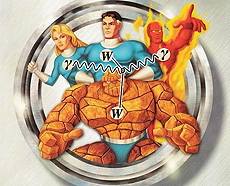 |
When four force carriers directly interact, they can be used as a powerful probe for new physics.
|
The Standard Model predicts a distinct behavior between force carrying particles when they directly interact with each other, so studying what happens when four force carriers simultaneously interact is a powerful test of the theory. By looking for a deviation from the predicted behavior, physicists can perform a generalized search for new physics without necessarily knowing what could be hiding in nature. The behavior of these interactions might differ from the Standard Model prediction if, for instance, there are extra dimensions of space or undiscovered, heavy particles that interact with the known force carriers. This powerful probe can be sensitive to particles that are much more massive than what can be directly produced in current particle accelerator collisions.
One four-boson interaction predicted by the Standard Model to contribute to W boson
pair production is the simultaneous interaction of two photons, the carriers of the electromagnetic force, and two W bosons, the massive, charged carriers of the weak force. A recent analysis at DZero examined the contribution of this interaction in the production of W boson pairs, which is predicted to be very small in the Standard Model. The analysis focused on events where each W boson decayed into an electron and a neutrino. The two neutrinos will not interact with the detector and are only noticed by the total imbalance of energy they leave behind, so the precise measurement of each electron is important to the analysis. The analyzers built a special discriminant to characterize each event and search for any anomalies in the behavior of the four-boson interaction.
After examining all of the DZero Run II data, the analyzers found that the Standard Model predictions are accurate for the simultaneous interaction of two photons and two W bosons. Their results set limits on the size of possible deviations from the Standard Model that are between 5 and 10 times better than the best previously published limits. The result from this powerful probe of force carrier interactions provides improved constraints for many new theories of physics beyond the Standard Model.
—Mike Cooke
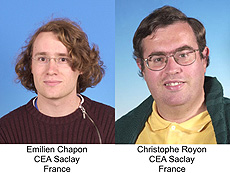 |
These physicists made major contributions to this analysis.
|
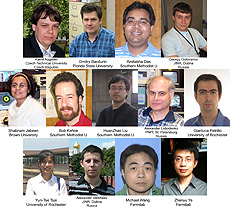 |
When a quark or gluon is produced by a particle collision, strong-force interactions quickly transform it into a spray of particles called a jet. The Jet Energy Scale Group handles the critical task of calibrating, monitoring and improving jet energy measurements to ensure they are as accurate as possible.
|
|
Coming up tails
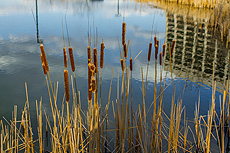 |
Cattails adorn the shores of the pond near Wilson Hall. Photo: Elliott McCrory, AD |
|
Photo of the Day photo credit
In yesterday's Photo of the Day, we misspelled the photographer's name. The photographer is Yury Suvorov of UCLA.
The photo credit is now corrected.
|
ESA: Herschel space telescope blinded by heat, retires for good
From the Los Angeles Times, April 29, 2013
Astronomers knew this day would come. The Herschel Space Observatory has run out of coolant and ceased looking into the cold, distant universe. Without liquid helium to keep the instruments chilled to minus 456 degrees Fahrenheit, the European Space Agency telescope began to run a fever and went blind, leading scientists on Monday to shutter this floating window into space.
Read more |
|